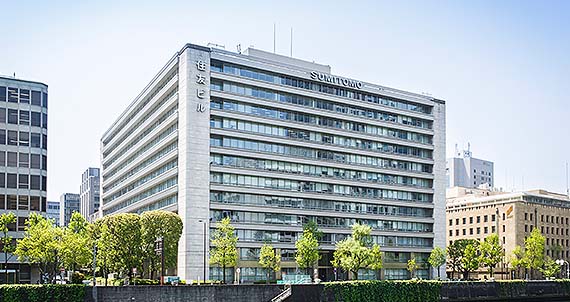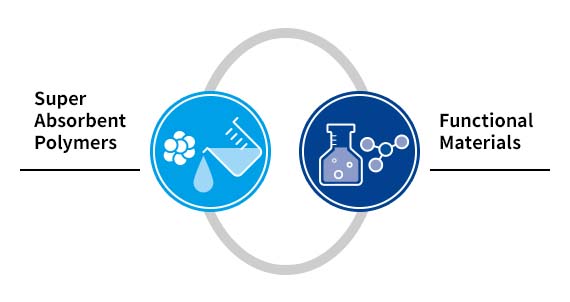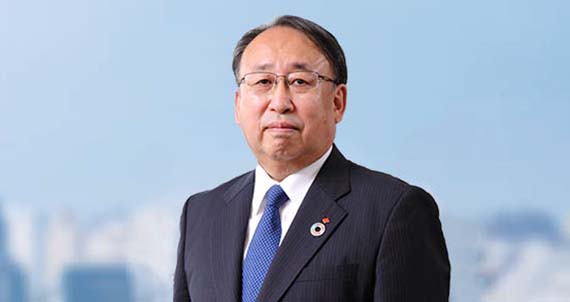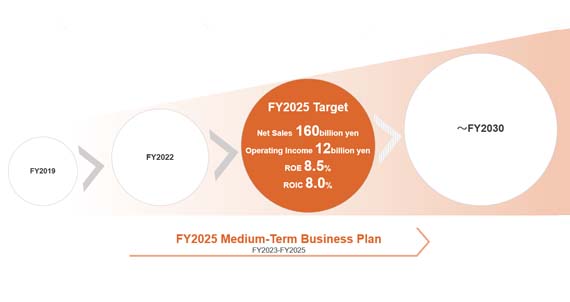Corporate Governance
At Sumitomo Seika, we believe that corporate governance is a means for a company to achieve sustainable growth and increase its corporate value over the medium to long term. We implement various initiatives to create and strengthen such a system.
Basic Stance
Sumitomo Seika is dedicated to our Corporate Mission: “Following the Sumitomo Business Spirit, the Sumitomo Seika Group will contribute to the advancement of society by developing world class creative technologies in the field of chemistry and, based thereon, supplying unique, high-quality products to people around the world.” In our efforts to attain sustainable growth and enhance our corporate value over the medium to long term, we are committed to strengthening and enhancing our corporate governance in line with the following policies.
- We ensure that our shareholders are provided with all of the information that they need to properly exercise their rights and with opportunities to exercise such rights, and that all shareholders are treated equally.
- We foster a corporate culture that respects the interests of our stakeholders, including shareholders, customers, employees, and local communities, and proactively cooperate with them.
- We establish and implement a code of conduct that our officers and employees must abide by and appropriately manage an internal control system.
- We ensure management transparency by promoting appropriate and adequate information disclosure. This includes publishing financial information in English and providing timely updates on our website.
- Given its fiduciary responsibilities and accountability to shareholders, the Board of Directors presents the management policies and corporate strategies of Sumitomo Seika Group and makes timely and bold decisions in order to promote sustainable growth and improve the Group’s medium to long term corporate value.
- We engage in constructive dialogue with our partner toward achievement of sustainable growth and increased medium to long term corporate value, and we clearly explain our management strategies and plans in an easily understandable manner through such dialogue.
History of Strengthening Corporate Governance
| Date | Main Initiatives |
|---|---|
| 2015 Jun. |
Selected two independent external directors (Increased from one) |
| Dec. |
Formulated the Sumitomo Seika Corporate Governance Guidelines |
| 2020 Jun. |
Selected three external auditors (one female) |
| 2021 Jun. |
Took the form of a company with an audit and supervisory committee |
| Nov. |
Formulated standards relating to the appointment of independent external directors |
| Dec. |
Established the Sustainability Committee |
| 2023 Jun. | Selected independent external directors with management experience |
| Aug. | Selected an independent external director as Chair of the Nomination and Compensation Committee |
| 2024 Jun. | Ratio of independent external directors on the Board of Directors to be 40% (including two women) |
Corporate Governance Structure
On June 25, 2021, we transitioned from a company with a board of corporate auditors structure to a company with an audit and supervisory committee structure in order to further enhance corporate governance and management transparency by strengthening the supervisory function of the Board of Directors, as well as to accelerate decision-making and thereby further increase our corporate value.
In order to strengthen corporate governance, realize efficient management, and enhance competitiveness, we have adopted an executive officer system that separates directors, who are responsible for formulating basic corporate policies, determining strategies, and supervising business execution, from executive officers, who focus on business execution.
Outline of Corporate Governance Structure
Board of Directors
As well as deciding on management strategies and other important management matters, in accordance with laws and regulations, the Board of Directors takes reports on business execution and other topics from individual directors, and provides oversight to directors’ business execution and other duties. To strengthen the management monitoring and supervision function, executive officers and other non-directors attend board meetings as necessary to explain the status of business execution.
The term for directors who are not members of the Audit and Supervisory Committee is one year, and candidates are nominated by the board, after considering reports by the Nomination and Compensation Committee, and then selected at the Shareholders Meeting.
Outline of the Board of Directors (FY2023)
| Chair |
President |
||||||||||||
|---|---|---|---|---|---|---|---|---|---|---|---|---|---|
| Members |
7 directors (excluding those who are members of the Audit and Supervisory Committee, and including 5 directors concurrently serving as executive officers) |
||||||||||||
| Frequency of Meetings |
Once a month in principle, with extraordinary meetings as necessary |
||||||||||||
| Number of Meetings |
13 times |
||||||||||||
| Attendance |
OGAWA Ikuzo 13 times out of 13 times (100%) Note: KATSUKI Yasumi resigned and YOSHIIKE Fujio was newly appointed at the 110th Annual Shareholders Meeting held on June 23, 2023. |
||||||||||||
| Main Issues Deliberated |
|
Nomination and Compensation Committee
This is a consultative body of the Board of Directors to ensure transparency and fairness in the selection of senior management, the nomination of directors, and the determination of their compensation. Committee members are appointed by the Board of Directors and consist of the President, the Director in charge of human resources, and an independent external director. A majority of the Committee members are independent external directors, and an independent external director is appointed as the Committee Chair.
Outline of Nomination and Compensation Committee (FY2023)
| Chair |
Independent external director |
|---|---|
| Members |
5 (of which there are 3 independent external directors) |
| Number of Meetings |
3 times |
| Main Activities |
Nominations
Determining compensation
|
Audit and Supervisory Committee
The Audit and Supervisory Committee audits directors' business execution from the perspective of legality and appropriateness, thereby contributing to the improvement of the Company's corporate governance. It also shares opinions and deliberates about, and investigates, a wide range of topics related to the suitability and effectiveness of management, and compliance, as well as offering advice or suggestions on legality and suitability.
The committee consists of one director (full-time Audit and Supervisory Committee member) and three external directors (Audit and Supervisory Committee members), and conducts effective audits by combining the independence of the part-time members with the information-gathering capabilities of the full-time member.
Outline of the Audit and Supervisory Committee (FY2023)
| Members |
4 directors (including 3 external directors) |
||||||
|---|---|---|---|---|---|---|---|
| Frequency of Meetings |
Once a month in principle, with extraordinary meetings as necessary |
||||||
| Number of Meetings |
14 times |
||||||
| Attendance |
MICHIBATA Mamoru 14 times out of 14 times(100%) Note: The number of meetings of the Audit and Supervisory Committee to be attended differs from that of the other members because MIURA Kunio stepped down as a member of the Audit and Supervisory Committee at the conclusion of the 110th Annual Shareholders Meeting held on June 23, 2023. In addition, YOSHIIKE Fujio was selected as Director on the Audit and Supervisory Committee at the 110th Annual Shareholders Meeting held on June 23, 2023, and therefore the number of Audit and Supervisory Committee meetings and Board of Directors meetings he attended is different from the other members. |
||||||
| Main Issues Deliberated |
|
Outline of the Committees and Frequency of Meetings
| Name | Outline |
Meeting Frequency |
|---|---|---|
| Management Meeting | The Management Meeting deliberates on the Group’s management strategies and other important management matters. |
24 times/year (twice/month) |
| Sustainability Committee | To advance sustainability management, the Sustainability Committee formulates sustainability policies and plans, confirms and improves on the progress of sustainability within the Company and in other group companies, and deliberates other matters required to promote sustainable management. |
Once/year |
| Internal Control Committee | In order to oversee the Company’s internal controls, the Internal Control Committee receives reports on the status of the operation of the internal control system and provides any needed instructions to each organization and the Risk and Compliance Committee to sustain and improve internal controls. |
3 times/year |
| Responsible Care Committee | To advance activities related to Responsible Care, the Responsible Care Committee deliberates and decides on the development of medium- and long-term plans for safety, environment, and quality (including risk and compliance). This includes formulating annual plans, implementing major changes to operational systems, and taking actions in response to significant issues. | 3 times/year |
| HR Committee | The HR Committee selects and trains candidates for management positions and deliberates on their promotion to or continuation in key roles (such as department manager level or above, special-grade reemployment, etc.). | Twice/year |
The president and the executive officers responsible for business operations attend each committee meeting. Full-time members of the Audit and Supervisory Committee also participate as observers to monitor and supervise business operations.
Moreover, the table above shows the frequency of meetings in principle only, while each committee meets on an as-needed basis on an ad hoc basis.
Corporate Governance Structure Chart
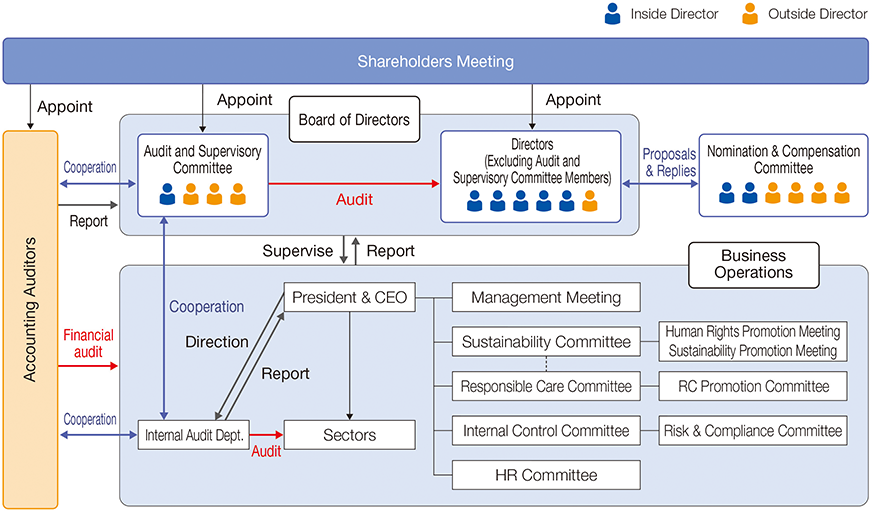
Evaluating the Effectiveness of the Board of Directors
As part of our efforts to ensure that the Board of Directors effectively fulfills and further improves its own roles and functions, we conduct an assessment of the effectiveness of the Board of Directors. Our most recent assessment of the effectiveness of the Board of Directors was conducted for fiscal 2023, and we are pleased to provide a summary of the results.
How we judge effectiveness
Board of Directors effectiveness evaluations are carried out according to the following processes.
- Each director completes a self-assessment (questionnaire)
- Interviews are conducted based on the answers given in (1)
- Based on (1) and (2), the current situation is analyzed, and issues identified
- The Board of Directors discusses the effectiveness evaluation and issues based on (3)
The areas of the self-assessment are as follows:
- Efficient operations of the Board of Directors and its systems (no. of agenda items and time allocated)
- Number, diversity, and skills of the Board of Directors
- Status of discussions, explanations, and reports at the Board of Directors
- Status of oversight by the Board of Directors (of areas such as implementation of business plans,risk management, internal controls, and compliance)
- Oversight of training for those who will succeed to executive posts
- Status of efforts toward issues identified in the previous yearʼs effectiveness evaluation
FY2023 Board of Directors effectiveness evaluation
Based on the results of the questionnaire and interviews conducted with each director, the Board of Directors of the Company discussed the effectiveness of the Board in fiscal 2023, the progress made in addressing previous issues, and areas for improvement to enhance the Board’s effectiveness in the future.
During the discussion, the Board confirmed that it is functioning properly, with active discussions taking place under appropriate management, and that efforts have been made to address previous issues, leading to improvements since last year.
Based on these discussions, we evaluated that the Board of Directors is fulfilling the roles and functions required to enhance corporate value. Additionally, we have identified issues to address this year to further improve the Board’s effectiveness. Details are as follows.
Status of efforts toward issues identified in the previous yearʼs effectiveness evaluation
The Board of Directors responded to issues identified in the previous yearʼs effectiveness evaluation as follows:
- Strengthen oversight of human resource strategy
(Challenges from last year)
To achieve the Company’s growth strategy, reports to the Board of Directors on the approach and efforts to fulfilling the human resource strategy and human capital management are to be enhanced.
(Response)
We have had several meetings on human resource strategy reports made to the Board of Directors and engaged in discussions on the matter. Additionally, we have made revisions to the skill set required by the Board of Directors of this Company based on these discussions. We will continue to integrate the perspective of external directors and push forward efforts to strengthening oversight of our human resource strategy. - Strengthen supply of information to external directors
(Challenges from last year)
Create opportunities for outside directors who are not members of the Audit and Supervisory Committee to hear explanations of the Company’s operations directly from each department of the Company, such as by attending site visits by the Audit and Supervisory Committee.
(Response)
With the approval of the Audit and Supervisory Committee, we attended the site visits. - Operation of the Nomination and Compensation Committee
(Challenges from last year)
Consider and prepare for the selection of the chair of the Nomination and Compensation Committee from outside the Company, with the aim of further improving transparency.
(Response)
After last year’s effectiveness assessment, an external director was selected as the chair of the Nomination and Compensation Committee. As the chair of the Nomination and Compensation Committee, the external director also reports to the Board of Directors on the status of the discussions of the Nomination and Compensation Committee. - Preparation method and volume of Board of Directors meeting materials
(Challenges from last year)
Improvement of materials for Board meetings and explanations of agenda items in order to ensure more time for discussion and improve effectiveness of Board meetings.
(Response)
We have worked to improve materials and explanations of agenda items. We will continue to work on further improvements in this area
Challenges in this year’s effectiveness assessment and responses in the future
Based on the results of the effectiveness assessment, we will take the following actions in the future.
- Facilitate communication between external directors and executives
For the purpose of promoting the exchange of information and opinions between external directors and executives, the Company will appoint an external director in charge of compiling opinions expressed at meetings of external directors to further stimulate the exchange of information among directors. - Involvement of external directors in internal committees
We will consider involving external directors in each committee related to internal human resources, sustainability, etc., with the expectation that the introduction of external perspectives into discussions among executives will deepen those discussions. - Improve operational efficiency of Board of Directors
Since the Company’s transition to having an Audit and Supervisory Committee, the number of matters to be reported at meetings of the Board of Directors has increased, and the time required for Board of Directors meetings has increased. In order to secure more time for deliberation of important matters, we will review items to be reported and reporting methods in order to improve the operational efficiency of the Board of Directors. - Other
Based on other requests for improvement received from directors to improve the effectiveness of the Board of Directors, the following responses will be taken.- Enhanced Board discussion of business (product) portfolio and allocation of management resources
- Enhanced reporting to and discussions within the Board of efforts to ensure product quality, including those of overseas Group companies
- Regular review of Board rules and basic internal control policies
Nomination and Compensation of Directors
Nomination of Candidates for Directors
The Board of Directors selects and discloses the skills (knowledge, experience, and abilities) that the Board collectively should possess to drive the Company’s sustainable growth and enhance corporate value. Additionally, we nominate candidates for the Board who not only have these essential skills but also meet our director selection criteria in terms of personal qualities. In doing so, we consider diversity, including gender, background, and nationality.
External Directors
We designate external directors as independent directors and notify the Tokyo Stock Exchange of their designation, in order for them to express their opinions on management policy and management improvement, supervise business execution, and ensure proper management from an independent and external standpoint.
At least one-third of the total number of directors are external independent directors. If circumstances arise in the future that require an increase in the number of external independent directors due to changes in the business environment or other factors, we will consider increasing the number of personnel according to the required fields.
Independence Criteria for Designation of Independent Directors
Independent external directors may be qualified as independent directors if they possess excellent ability, experience and insight that contribute to the management of the Company and can be expected to contribute to frank, active and constructive discussions at the Board of Directors, and if none of the following a. through i. apply.
- An executor of the business of the Company or a company of the Company’s Group (a director other than an external director, an executive officer, or an employee [by whatever name, any person having an employment relationship with the Company or a company of the Company’s Group])
- An executor of the business of a major customer or business partner. A major customer or business partner means a person who falls under any of the following items.
- A business partner providing products or services to the Company or a customer to whom the Company is providing products or services of which the total amount of such transactions in the most recent business year relevant to intended designation as an independent officer exceeds 2% of the Company’s unconsolidated sales or exceeds 2% of their sales to the Company
- A financial institution providing loans to the Company of which the total amount at the end of the most recent business year relevant to intended designation as an independent officer exceeds 2% of the Company’s unconsolidated loans; provided, however, that even if the amount does not exceed 2%, a financial institution stated as a lender to the Company on annual securities reports, business reports, or other public documents shall be included in major business partners
- A consultant, certified public accountant, attorney, or other expert receiving remuneration from the Company other than remuneration for officers of which the total amount of the remuneration paid, other than the remuneration for officers from the Company, in the most recent business year relevant to intended designation exceeds 10 million yen
- A person who belongs to an organization that is a consulting firm, tax accounting firm, law office, other corporate body, or partnership, which has transactions with the Company, and whose sales to the Company in the most recent business year relevant to intended designation as an independent officer exceeds 2% of the organization’s total sales or 10 million yen, whichever is larger
- A shareholder of the Company whose share of voting rights at the end of the most recent business year relevant to intended designation as an independent officer is 10% or more (a total of direct and indirect holdings) of the total voting rights or an executor of the business at the shareholder entity
- Of the companies in which the Company holds shares, a company in which the Company’s share of the voting rights at the end of the most recent business year relevant to intended designation as an independent officer is 10% or more (a total of direct and indirect holdings) of the total voting rights or an executor of the business at the shareholder entity
- A person who belongs to an auditing firm that conducts statutory audits of the Company
- A person to whom a above was applicable in the past or to whom any of b. to g. above was applicable in the past five years
- A spouse or a relative (within a second degree of kinship) of a person to whom any of a. to h. above applies
Compensation for Directors
1. Remuneration decision-making policy
- Basic Policy for Determining Compensation Amounts
- The compensation system for directors and executives (executive officers with control over business operations) uses the achievement of performance targets as an incentive and aims for long-term increases in corporate value, not just quick profits.
- Compensation shall be set at a level that is competitive in terms of attracting and retaining human resources, while taking into consideration the size and nature of the Company's business and other factors.
- Whether the level of compensation is reasonable or not is something that is reviewed using objective materials.
- The amount of individual compensation shall be determined based on whether or not the director concurrently serves as an executive officer, the executive officer's position (president, senior managing director, managing director, without role, etc.), and whether he/she is independent.
- The transparency and fairness of decisions about compensation are ensured with contributions from the Nomination and Compensation Committee, more than half of whose members are independent external directors.
- Compensation for directors who are members of the Audit and Supervisory Committee shall be limited to base remuneration only, and shall be determined through consultation among the Audit and Supervisory Committee members within the scope of the total amount of remuneration determined by a resolution of the Shareholders Meeting.
- Compensation Breakdown
- Compensation for directors and executives comprises two elements: fixed compensation (“base compensation”) and compensation linked to the Companyʼs business performance (“performance-linked compensation”) that takes the form of bonuses or stock-based compensation in the Company.
- Directors who are not involved in business execution are responsible for monitoring and overseeing management; as such, they only receive base compensation.
- o The ratio of the annual basic compensation and performance-linked compensation (including bonuses and stock compensation) for directors performing business operations is designed to fall within the following ranges. This is based on achieving the target performance indicator of ¥12 billion, the final-year goal in the medium-term management plan (fiscal years 2023 to 2025), and considers whether the directors and executive officers hold concurrent positions and the position of the executive officer (below “position, etc.”). The ratio of the annual basic compensation and performance-linked compensation (including bonuses and stock compensation) is designed to fall within the following ranges. It considers whether the directors and executive officers hold concurrent positions and the position of the executive officer (below “position, etc.”) and is based on achieving the target performance indicator of ¥12 billion in the final-year goal in the medium-term management plan (fiscal years 2023 to 2025).
Basic compensation (fixed compensation) Performance-linked compensation (bonuses) Performance-linked compensation (stock compensation) 64-69% 20-27% 9-13% - The share price per share is calculated at 5,090 yen, which is the closing price on March 29, 2024.
- Base compensation
- Base compensation is according to roles and responsibilities, in order to function as the foundational remuneration for professional duties.
- Base compensation is paid as a pecuniary amount, monthly.
- Performance-linked compensation
- Bonuses: As short-term incentives tied into achievement of targets set in the medium-term business plan, these fluctuate depending on the consolidated performance for each fiscal year, and are paid as a pecuniary amount at a fixed time each year (scheduled for the end of June).
- Stock-based compensation is positioned as a medium- and long-term incentive to promote a greater sharing of value with shareholders and sustainable growth for the Company. This is paid at a time decided by the Board of Directors.
2. Mechanisms of Each Compensation Element
- Base compensation
- The base compensation amount shall not be changed during the term of office (one year).
- Should the "size of the Company" (net sales, market capitalization, number of employees) and "profitability" (operating income, ROE, D/E ratio) change, this will be reflected in the amount for the following year (term of office).
- Performance-linked compensation and bonuses (short-term incentives)
- These are paid on the proviso that consolidated operating income for the relevant fiscal year reaches or exceeds 5 billion yen, and are determined according to the formula below.
Bonus calculation formula: performance indicator x coefficient - The performance indicator is the sum of consolidated operating income and financial balance, in order to reflect the consolidated performance for each fiscal year.
- The coefficient is used to calculate the amount of bonus (set by position, etc., and according to whether the recipient is also a director and according to their position, with the higher the position, the higher the coefficient) based on the ratio given in the above chart, and the relevant bonus amount is set as a division of the target of 12 billion yen.
- It is possible to reflect individual performance for each person's bonus within a range of +/- 10% based on the caluculation formula. However, the total bonus amount does not change.
- These are paid on the proviso that consolidated operating income for the relevant fiscal year reaches or exceeds 5 billion yen, and are determined according to the formula below.
- Performance-linked compensation and stock-based compensation (medium- and long-term incentives)
- Transfer-restricted stock in the form of common shares of the Company is granted in a number dependent on the recipientʼs position and other factors (however, the grant takes the form of payment as monetary claims equivalent to the price of the relevant shares; for directors and executives it will be paid in as property contributed in kind, to be received as shares of the Companyʼs common stock to be issued or disposed of).
- The number of shares is determined based on the ratio given in the above chart, according to whether the recipient is also a director and with the higher the position, the higher the number.
- Recipients must hold the shares until they resign or retire from the position by the Company.
3. Organization and Procedures for Determining Directorsʼ Compensation
Shareholders Meeting
It was resolved and approved at the 108th Annual Shareholders Meeting, which was held on June 25, 2021, that the total annual amount of compensation for all directors who are not members of the Audit and Supervisory Committee shall be not more than 360 million yen (including 20 million yen for external directors). The number of executives to which this resolution relates is eight (including one external director).
It was also resolved and approved at the 108th Annual Shareholders Meeting held on June 25, 2021, that the total annual amount of compensation for all directors who are members of the Audit and Supervisory Committee shall be not more than 60 million yen. The number of directors to which this resolution relates is four.
At the 110th Annual Shareholders Meeting held on June 23, 2023, it was determined that the total amount set aside for transfer-restricted shares to directors shall be set to not more than 90 million yen per annum. The number of executives affected by this resolution is five directors (excluding those who are members of the Audit and Supervisory Committee, outside directors, and non-executive directors).
Board of Directors and Consultative Body
The Company has established the Nomination and Compensation Committee for the purpose of ensuring transparency and fairness in determining the compensation for executives and directors who are not members of the Audit and Supervisory Committee. The Committee consists of the President, the Director in charge of human resources, and independent external directors, and the Committee members are selected so that a majority of the Committee members are independent external directors. The Committee is chaired by an independent external director.
The Board of Directors deliberates and determines the policy and method of determining compensation for directors and executive officers based on advice from the Nomination and Compensation Committee. As they perform corporate management under the leadership of top management, the amounts of individual compensation for executives and directors who are not members of the Audit and Supervisory Committee for the relevant fiscal year have been delegated by Board of Directors decision to President to determine. Conditions to this delegation to the president have been set:(1) the amount of individual compensation for executives and directors who are not members of the Audit and Supervisory Committee is determined in accordance with relevant policies, and (2) the president will ask the Nomination and Compensation Committee to look at individual compensation amounts and decide whether or not they are suitable, according to the compensation determination policy above, and will accept the committee's answer when they decide they are suitable. Through the above, we have ensured that the president exercised his authority appropriately, and judged that the individual compensation amounts for executives and directors who are not Audit and Supervisory Committee members are in line with relevant policies.
Nomination and Compensation Committee
Roles of the Nomination and Compensation Committee
In order to ensure objectivity, transparency and fairness in the selection process of directors and executive officers, the Nomination and Compensation Committee deliberates on the following matters and provide opinions to the Board of Directors.
- Criteria for the selection of directors
- Skill sets required of the Board of Directors
- Nomination of candidates for directors and selection and dismissal of executive officers
- Policy on compensation for directors and senior management (executive officers and other management)
- Determination of the individual amount of compensation for directors and executive officers
The Activities Details of the Nomination and Compensation Committee
Committee and other activities related to executives nomination and compensation in fiscal 2023 were as follows.:
- Nomination and Compensation Committee: 3 meetings
- Deliberations on revisions to the introduction of a stock compensation plan
- Deliberations on fixed compensation
- Deliberations on performance-linked compensation
- Deliberations about executive officer selection




